We are delighted to share an article by a friend of the school and dedicated Krav Maga practitioner, Chris Austria. Chris is a multitalented wildlife conservationist, currently living in Uganda where he works with the Chimpanzee Sanctuary and Wildlife Conservation Trust in Entebbe. His background with Krav Maga training had some surprising impact on his careers as a police officer, and as a tiger trainer. Chris is working towards being a certified Krav Maga instructor in the future in order to share his enthusiasm and passion for a skill that has saved his life many times over. Read more about Chris on his website http://www.chrisaustria.com
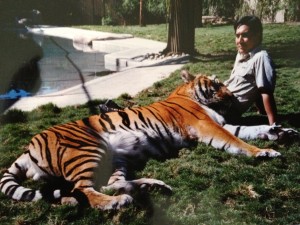 For most of my life, I have chosen highly dangerous careers. My experience as a police officer in California, a tiger and lion trainer, and as a wildlife conservationist have given me very rich experiences, but I have also been in life threatening circumstances as a result. My training in Krav Maga saved my life. The training has protected me in numerous situations in the U.S. and during my work overseas.
For most of my life, I have chosen highly dangerous careers. My experience as a police officer in California, a tiger and lion trainer, and as a wildlife conservationist have given me very rich experiences, but I have also been in life threatening circumstances as a result. My training in Krav Maga saved my life. The training has protected me in numerous situations in the U.S. and during my work overseas.
I would like to share a few of the key lessons that I learned from Krav Maga and how it has applied in my life.
1. Be Committed
I was first introduced to Krav Maga through my defense tactics instructors in the police department. The supplemental Krav Maga training geared specifically for law enforcement officers took the defense tactics skills that I learned at the police academy to a higher level. We were trained in Krav Maga techniques, both standing and on the ground, emphasizing the importance of explosiveness, speed, and adopting the attitude of never giving up.
My instructors stressed the importance of the use of force continuum—we had to know when it was appropriate to use the Krav Maga strikes. We trained to be prepared for anything—an attack could come at any time; when you are getting out of your patrol car, or looking down while writing a ticket. They taught us the importance of awareness, scanning your surroundings and using proper defensive positioning when dealing with suspects. In particular, the Krav Maga mentality of always staying in the fight with 100% commitment really had an impact on me.
One year following our Krav Maga seminar, I was involved in a situation while on patrol where I had to rely on my training in order to protect myself. I made contact with a suspect in the middle of the night when I was by myself in a dangerous neighborhood. This individual had an extensive criminal record and was under the influence of narcotics. As soon as my backup arrived, he immediately ran away from us. We initiated a foot pursuit, eventually taking him to the ground. Confrontations on the ground can put an officer in an extremely vulnerable position, but sometimes it’s inevitable. The suspect was very strong, non-compliant, and was successfully fighting both of us for what felt like a long time. I was fatigued and winded, especially after running four blocks with all my police gear. During this extended struggle, I fell back on my Krav Maga training and continued with 100% commitment and heart. While we were wrestling on the ground, despite being fatigued, I was able to control and deflect his attacks, preventing him from striking me. We were eventually able to handcuff him and place him under custody.
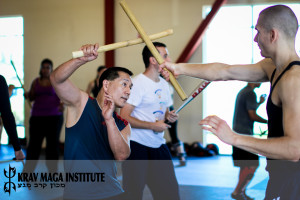 I believe it is this Krav Maga focus on mental strength that enabled us to arrest the suspect without being seriously injured. It’s important to remember that when you are in a fight, you will be tired, out of breath, your body will hurt, and you may be injured, but you have to keep going, no matter how difficult the circumstances are. You might not always have the advantage of position or strength, but you must be fully committed to prevailing. This commitment needs to be honed during your training. My way of thinking has never been “if an attack will occur,” but “when an attack occurs.” If you don’t fight with 100% effort, you might not survive!
I believe it is this Krav Maga focus on mental strength that enabled us to arrest the suspect without being seriously injured. It’s important to remember that when you are in a fight, you will be tired, out of breath, your body will hurt, and you may be injured, but you have to keep going, no matter how difficult the circumstances are. You might not always have the advantage of position or strength, but you must be fully committed to prevailing. This commitment needs to be honed during your training. My way of thinking has never been “if an attack will occur,” but “when an attack occurs.” If you don’t fight with 100% effort, you might not survive!
2. Hone your Awareness and Instinctive Response
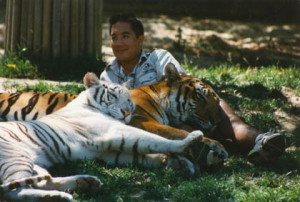 For many years, I was a tiger and lion trainer at Six Flags in Vallejo, CA as well as other wildlife sanctuaries in the U.S. The tigers that we worked with were all hand-raised and bottle-fed in captivity. Remember, it is not possible to tame or domesticate big cats, even when they are raised as young cubs. We developed a relationship with all of them, based on trust and respect. Although the big cats were very well trained, they were still wild animals, and displayed aggressive behaviors towards their trainers. At times, their natural wild nature resulted in very serious injuries.
For many years, I was a tiger and lion trainer at Six Flags in Vallejo, CA as well as other wildlife sanctuaries in the U.S. The tigers that we worked with were all hand-raised and bottle-fed in captivity. Remember, it is not possible to tame or domesticate big cats, even when they are raised as young cubs. We developed a relationship with all of them, based on trust and respect. Although the big cats were very well trained, they were still wild animals, and displayed aggressive behaviors towards their trainers. At times, their natural wild nature resulted in very serious injuries.
One of the cats that I worked with was a 7-year-old female named Jai. This tigress was incredibly beautiful, highly aggressive, and full of fury. She also could be very sweet and affectionate. Because of her moody and changeable nature, Jai was fascinating to work with. Due to her aggression towards the other tigers, Jai was transferred to a wildlife centre in Oregon where she had a large area all to herself, away from other cats. I visited the centre every weekend to help take care of Jai and to take her on walks.
I was fortunate to work with Rob, another experienced tiger trainer, and he accompanied me and Jai on our walks. One morning, as we walked out of the centre, I suddenly realized that we forgot to bring a small bottle of low fat milk with us. Milk is a training reward that we used regularly in our work, and the tigers loved it. Rob went back to get the milk, and we continued on our walk.
As we continued our ascent up the mountains, it was apparent to me that Jai was acting peculiar. She was rubbing her head up against my leg, very similar to your house cat when he or she is acting affectionate. This time was different however, because her neck and head were stiff. It felt as if she was leaning up against me to assess my balance.
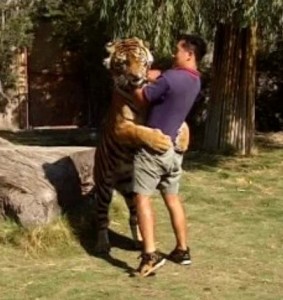 I called Jai’s name out and chuffed to her (a friendly sound that tigers make as a greeting). She chuffed back, glanced up at me, then quickly looked away. I could sense the wheels turning in Jai’s head, as if she was planning, calculating, and strategizing—something Jai was famous for. She was avoiding eye contact, knowing that if I saw her eyes, I would know she was planning an aggressive maneuver. Jai was pretending to act friendly in order to lure me into a false sense of security.
I called Jai’s name out and chuffed to her (a friendly sound that tigers make as a greeting). She chuffed back, glanced up at me, then quickly looked away. I could sense the wheels turning in Jai’s head, as if she was planning, calculating, and strategizing—something Jai was famous for. She was avoiding eye contact, knowing that if I saw her eyes, I would know she was planning an aggressive maneuver. Jai was pretending to act friendly in order to lure me into a false sense of security.
My senses were on fire. Working with the tigers combined with my Krav Maga training honed my awareness skills and taught me to follow my instincts. As we walked higher up the mountains, I could feel that gut feeling inside telling me to watch this tiger’s every move. Jai walked ahead, still on the leash, about 8 feet away from me. She was now on the uphill side with her back towards me, and I was standing on the decline. Jai had a strong predatory intelligence, purposefully waiting until she was at this position of advantage. I said to her, “Good girl, Jai. Do you want to go back?” Jai looked back at me, over her shoulder and her eyes flashed with a sudden green fury.
With lightning speed, Jai launched her 300 lb. body at me, pouncing with incredible force. She roared loudly, her mouth gaping wide, exposing her 2.5 inch canines. Instinctively, I stepped into a solid fighting stance, left foot forward, right foot back, and both arms up to protect my head and face. As Jai swiped at me with her claws extended out, I deflected her paws with my arms. I felt sharp pains in my face and knew that I had been injured.
Rob immediately gave Jai a disciplinary strike on the nose with a wooden cane, causing her to stop, as she was trained to do. She then backed up, and positioned herself behind a pine tree. All I could see was Jai’s one eye staring intensely at me. I knew she was planning a second attack. I pulled out the low fat milk bottle, which completely distracted her; again, a result of our training. She walked out from behind the tree, and began lapping up the milk, which was now frozen.
Fortunately, after Jai drank the milk, she calmed down and we were able to walk her back. This was the longest 30-minute walk of my life. I was light headed, bleeding profusely from my face, but knew that I had to keep my composure around such a powerful predator. We successfully returned with no further incident, and I was rushed to the hospital for treatment.
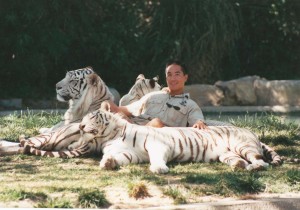 As I reflect back on this event, it is very obvious to me that if I didn’t step into a solid Krav Maga fighting stance with my arms up, Jai probably would have injured me more seriously or killed me. The training I received to immediately and instinctively respond to a threat and the “never give up” attitude that I learned from Krav Maga was essential in this life and death circumstance. The mental training that we receive is as important as the physical training. My co-worker Rob, low-fat milk, and Krav Maga literally saved my life.
As I reflect back on this event, it is very obvious to me that if I didn’t step into a solid Krav Maga fighting stance with my arms up, Jai probably would have injured me more seriously or killed me. The training I received to immediately and instinctively respond to a threat and the “never give up” attitude that I learned from Krav Maga was essential in this life and death circumstance. The mental training that we receive is as important as the physical training. My co-worker Rob, low-fat milk, and Krav Maga literally saved my life.
Last year, Jai passed away peacefully of natural causes. I will miss her. Despite our difficulties, I loved this tigress. She was one of my greatest teachers, and I will never forget her. The times we shared together will forever be etched in my memories.
3. De-Escalate Whenever Possible
Last year, I began training at the Krav Maga Institute. I was so impressed with the high-level of instruction given by the Institute. Danny Zelig and his instructor team are extremely capable, and they are all great teachers who focus on realism and practicality.
My work with tigers and lions eventually led me to wildlife conservation work overseas. I have met some of the kindest and warmest people while living in a foreign country, but I had a few occasions where I had to rely on my Krav Maga skills. Recently, the training I received at KMI proved highly valuable. I have seen and experienced firsthand the value of knowing when and how to de-escalate aggressive situations in order to avoid a more serious fight.
In one instance overseas, my wife, a friend, and I were being harassed by three individuals at an outdoor event. Two of the men were in my friend’s face and not backing down. They were shouting in a language that I was not fluent in, so it was difficult for me to know exactly what the problem was, or how to diffuse the conflict. I had to assess the situation and make a decision before it got worse. I decided to give one of the men an open palm strike to the chest with both hands, which caused both of individuals to back off, realizing that I was serious about defending myself and my company. 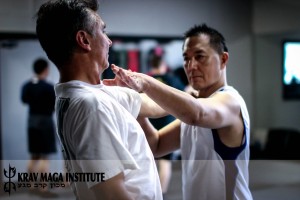 I learned this open palm strike at a KMI seminar a couple months before this incident. One the men then ran over to grab a large rock to throw at us, but we already had planned our exit strategy, and fortunately the police arrived at this time.
I learned this open palm strike at a KMI seminar a couple months before this incident. One the men then ran over to grab a large rock to throw at us, but we already had planned our exit strategy, and fortunately the police arrived at this time.
Krav Maga training also instills a natural confidence, and because of how I carry myself, I have been able to “convince” would-be attackers to back off without a more serious confrontation. In another situation on a crowded street in a foreign country, I had two men on either side of me grab my arms. This is a common technique when people want to take your belongings out of your pockets. I delivered quick elbow strikes and exited away from the two men. I believe that it is always important to send a very clear, direct, and unmistakable message that you are confident, and serious about your self-protection.
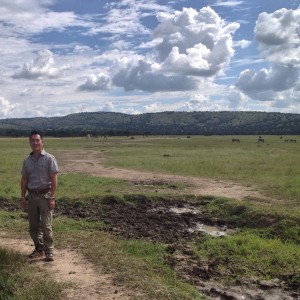 Awareness and our demeanor is equally important as the fighting skills we train in. Kfir taught me an important lesson on de-escalation tactics during the “Holds and Restraints” seminar. He pointed out to me during our training that I had an aggressive scowl on my face. He said it is more advantageous to relax and smile so that you do not alert your aggressors of your fight intentions. This has worked for me overseas. When confronted on the street with aggressors, I confidently greet them in their language with a smile on my face. This causes them to back down. Although I am prepared, I make it a point to not get in a “fighting stance.” I learned that immediately assuming the fighting stance escalates the situation, puts an aggressor on the defensive, and if you are forced to take action, you lose the element of surprise which is another tenet of Krav Maga.
Awareness and our demeanor is equally important as the fighting skills we train in. Kfir taught me an important lesson on de-escalation tactics during the “Holds and Restraints” seminar. He pointed out to me during our training that I had an aggressive scowl on my face. He said it is more advantageous to relax and smile so that you do not alert your aggressors of your fight intentions. This has worked for me overseas. When confronted on the street with aggressors, I confidently greet them in their language with a smile on my face. This causes them to back down. Although I am prepared, I make it a point to not get in a “fighting stance.” I learned that immediately assuming the fighting stance escalates the situation, puts an aggressor on the defensive, and if you are forced to take action, you lose the element of surprise which is another tenet of Krav Maga.
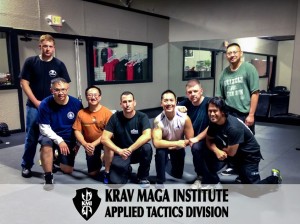 Although I spend most of the time out of the U.S., I continue my training overseas, and look forward to taking Krav Maga classes at KMI in the future. Many thanks to Danny Zelig, Kfir Cohen, and all the instructors at the Krav Maga Institute.
Although I spend most of the time out of the U.S., I continue my training overseas, and look forward to taking Krav Maga classes at KMI in the future. Many thanks to Danny Zelig, Kfir Cohen, and all the instructors at the Krav Maga Institute.
Chris Austria
www.chrisaustria.com
One Response to “My Life in Krav Maga, Police Work, and Tiger Training”
Opolot Immanuel
Your story is impressive, Chris.. would definitely love a catch up. If yo still within Entebbe.
Write to me on that e.mail, please.
I’m one of Krav-Maga addicts. Had my initial training with Israeli instructors.